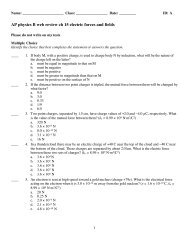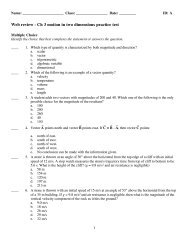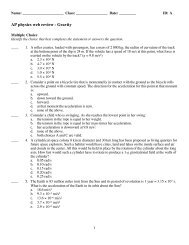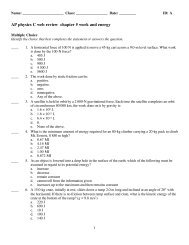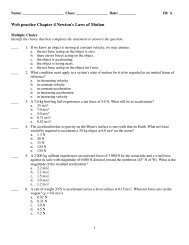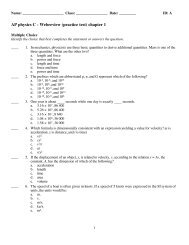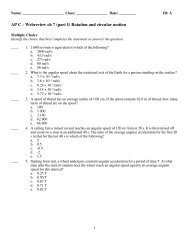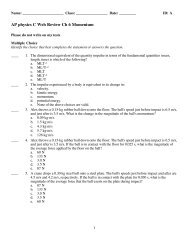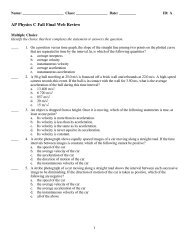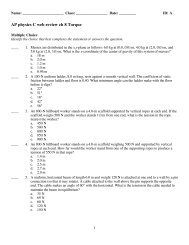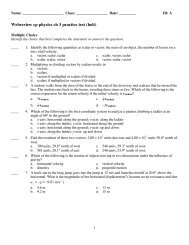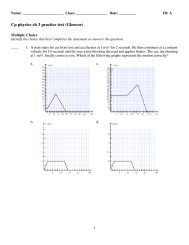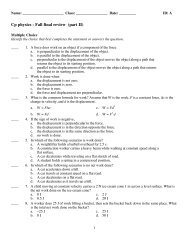AP physics C --- Webreview --- chapter 13 oscillations
AP physics C --- Webreview --- chapter 13 ... - Planet Holloway
AP physics C --- Webreview --- chapter 13 ... - Planet Holloway
- No tags were found...
You also want an ePaper? Increase the reach of your titles
YUMPU automatically turns print PDFs into web optimized ePapers that Google loves.
Name: ______________________ Class: _________________ Date: _________<br />
ID: A<br />
<strong>AP</strong> <strong>physics</strong> C --- <strong>Webreview</strong> --- <strong>chapter</strong> <strong>13</strong> <strong>oscillations</strong><br />
Multiple Choice<br />
Identify the choice that best completes the statement or answers the question.<br />
____ 1. A large spring requires a force of 150 N to compress it only 0.010 m. What is the spring constant of<br />
the spring?<br />
a. 125 000 N/m<br />
b. 15 000 N/m<br />
c. 15 N/m<br />
d. 1.5 N/m<br />
e. 1.0 N/m<br />
____ 2. Tripling the weight suspended vertically from a coil spring will result in a change in the displacement<br />
of the spring's lower end by what factor?<br />
a. 0.33<br />
b. 1.0<br />
c. 3.0<br />
d. 9.0<br />
e. 12<br />
____ 3. A tiny spring, with a spring constant of 1.20 N/m, will be stretched to what displacement by a 0.005<br />
0-N force?<br />
a. 4.2 mm<br />
b. 6.0 mm<br />
c. 7.2 mm<br />
d. 9.4 mm<br />
e. 11 mm<br />
____ 4. Suppose there is an object for which F = +kx. What will happen if the object is moved away from<br />
equilibrium (x = 0) and released?<br />
a. It will return to the equilibrium position.<br />
b. It will move further away with constant velocity.<br />
c. It will move further away with constant acceleration.<br />
d. It will move further away with increasing acceleration.<br />
e. None of the above.<br />
____ 5. Which is not an example of approximate simple harmonic motion?<br />
a. A ball bouncing on the floor.<br />
b. A child swinging on a swing.<br />
c. A piano string that has been struck.<br />
d. A car's radio antenna as it waves back and forth.<br />
e. Both choices A and D are valid.<br />
____ 6. A 0.20 kg object, attached to a spring with spring constant k = 10 N/m, is moving on a horizontal<br />
frictionless surface in simple harmonic motion of amplitude of 0.080 m. What is its speed at the<br />
instant when its displacement is 0.040 m? (Hint: Use conservation of energy.)<br />
a. 9.8 m/s<br />
b. 4.9 m/s<br />
c. 49 cm/s<br />
d. 24.5 cm/s<br />
e. 53 cm/s<br />
1
Name: ______________________<br />
ID: A<br />
____<br />
____<br />
____<br />
____<br />
____<br />
____<br />
7. A mass of 0.40 kg, hanging from a spring with a spring constant of 80 N/m, is set into an<br />
up-and-down simple harmonic motion. What is the speed of the mass when moving through a point<br />
at 0.05 m displacement? The starting displacement of the mass is 0.10 m from its equilibrium<br />
position.<br />
a. zero<br />
b. 1.4 m/s<br />
c. 1.7 m/s<br />
d. 1.2 m/s<br />
e. 1.0 m/s<br />
8. A 0.20-kg mass is oscillating on a spring over a horizontal frictionless surface. When it is at a<br />
displacement of 2.6 cm for equilibrium it has a kinetic energy of 1.4 J and a spring potential energy<br />
of 2.2 J. What is the maximum speed of the mass during its oscillation?<br />
a. 3.7 m/s<br />
b. 4.7 m/s<br />
c. 6.0 m/s<br />
d. 6.3 m/s<br />
e. 7.8 m/s<br />
9. Suppose a 0.3-kg mass on a spring that has been compressed 0.10 m has elastic potential energy of<br />
1.0 J. How much further must the spring be compressed to triple the elastic potential energy?<br />
a. 0.30 m<br />
b. 0.20 m<br />
c. 0.17 m<br />
d. 0.07 m<br />
e. 0.05 m<br />
10. An ore car of mass 4 000 kg rolls downhill on tracks from a mine. At the end of the tracks, 10.0 m<br />
lower in elevation, is a spring with k = 400 000 N/m. How much is the spring compressed in stopping<br />
the ore car? Ignore friction.<br />
a. 0.14 m<br />
b. 0.56 m<br />
c. 1.40 m<br />
d. 1.96 m<br />
e. 2.43 m<br />
11. By what factor must one change the weight suspended vertically from a spring coil in order to triple<br />
its period of simple harmonic motion?<br />
a. 1/9<br />
b. 0.33<br />
c. 3.0<br />
d. 9.0<br />
e. 12<br />
12. A mass on a spring vibrates in simple harmonic motion at a frequency of 4.0 Hz and an amplitude of<br />
8.0 cm. If the mass of the object is 0.20 kg, what is the spring constant?<br />
a. 40 N/m<br />
b. 87 N/m<br />
c. 126 N/m<br />
d. 160 N/m<br />
e. 190 N/m<br />
2
Name: ______________________<br />
ID: A<br />
____<br />
____<br />
____<br />
____<br />
____<br />
____<br />
<strong>13</strong>. For a mass suspended on a spring in the vertical direction, the time for one complete oscillation will<br />
depend on:<br />
a. the value for g (the acceleration due to gravity).<br />
b. the distance the mass was originally pulled down.<br />
c. the maximum speed of the oscillating mass.<br />
d. the time doesn't depend on any of the above.<br />
e. both choices A and C are valid.<br />
14. A mass on a spring vibrates in simple harmonic motion at a frequency of 4.0 Hz and an amplitude of<br />
4.0 cm. If a timer is started when its displacement is a maximum (hence x = 4 cm when t = 0), what is<br />
the acceleration magnitude when t = 3 s?<br />
a. zero<br />
b. 8.<strong>13</strong> m/s 2<br />
c. 14.3 m/s 2<br />
d. 25.3 m/s 2<br />
e. 32.4 m/s 2<br />
15. A mass on a spring vibrates in simple harmonic motion at a frequency of 4.0 Hz and an amplitude of<br />
8.0 cm. If a timer is started when its displacement is a maximum (hence x = 8 cm when t = 0), what is<br />
the displacement of the mass when t = 3.7 s?<br />
a. zero<br />
b. 0.025 m<br />
c. 0.036 m<br />
d. 0.080 m<br />
e. 0.095 m<br />
16. The motion of a piston in an automobile engine is nearly simple harmonic. If the 1-kg piston travels<br />
back and forth over a total distance of 10.0 cm, what is its maximum speed when the engine is<br />
running at 3 000 rpm?<br />
a. 31.4 m/s<br />
b. 15.7 m/s<br />
c. 7.85 m/s<br />
d. 3.93 m/s<br />
e. 1.66 m/s<br />
17. The position of a 0.64-kg mass undergoing simple harmonic motion is given by x = (0.160 m) cos<br />
(πt/16). What is its period of oscillation?<br />
a. 100 s<br />
b. 32 s<br />
c. 16 s<br />
d. 8.0 s<br />
e. 4.5 s<br />
18. The position of a 0.64-kg mass undergoing simple harmonic motion is given by x = (0.160 m) cos<br />
(πt/16). What is the maximum net force on the mass as it oscillates?<br />
a. 3.9 × 10 -3 N<br />
b. 9.9 × 10 -3 N<br />
c. 1.3 × 10 -3 N<br />
d. 5.4 × 10 -2 N<br />
e. 6.3 N<br />
3
Name: ______________________<br />
ID: A<br />
____<br />
____<br />
____<br />
____<br />
____<br />
19. The position of a 0.64-kg mass undergoing simple harmonic motion is given by x = (0.160 m) cos<br />
(πt/16). What is its position at t = 5.0 s?<br />
a. 0.160 m<br />
b. 0.159 m<br />
c. 0.1<strong>13</strong> m<br />
d. 0.089 m<br />
e. 0.076 m<br />
20. The kinetic energy of the bob on a simple pendulum swinging in simple harmonic motion has its<br />
maximum value when the displacement from equilibrium is at what point in its swing?<br />
a. zero displacement<br />
b. 1/4 the amplitude<br />
c. 1/2 the amplitude<br />
d. 3/4 the amplitude<br />
e. equal the amplitude<br />
21. Tripling the mass of the bob on a simple pendulum will cause a change in the frequency of the<br />
pendulum swing by what factor?<br />
a. 0.33<br />
b. 1.0<br />
c. 3.0<br />
d. 9.0<br />
e. 12<br />
22. A simple pendulum of length 1.00 m has a mass of 100 g attached. It is drawn back 30.0° and then<br />
released. What is the maximum speed of the mass?<br />
a. 1.14 m/s<br />
b. 3.<strong>13</strong> m/s<br />
c. 2.21 m/s<br />
d. 1.62 m/s<br />
e. 2.56 m/s<br />
23. A simple pendulum has a mass of 0.25 kg and a length of 1.0 m. It is displaced through an angle of<br />
30° and then released. After a time, the maximum angle of swing is only 10°. How much energy has<br />
been lost to friction?<br />
a. 0.29 J<br />
b. 0.65 J<br />
c. 0.80 J<br />
d. 1.0 J<br />
e. 1.2 J<br />
4
ID: A<br />
<strong>AP</strong> <strong>physics</strong> C --- <strong>Webreview</strong> --- <strong>chapter</strong> <strong>13</strong> <strong>oscillations</strong><br />
Answer Section<br />
MULTIPLE CHOICE<br />
1. B<br />
2. C<br />
3. A<br />
4. D<br />
5. A<br />
6. C<br />
7. D<br />
8. C<br />
9. D<br />
10. C<br />
11. D<br />
12. C<br />
<strong>13</strong>. D<br />
14. D<br />
15. B<br />
16. B<br />
17. B<br />
18. A<br />
19. D<br />
20. A<br />
21. B<br />
22. D<br />
23. A<br />
1



